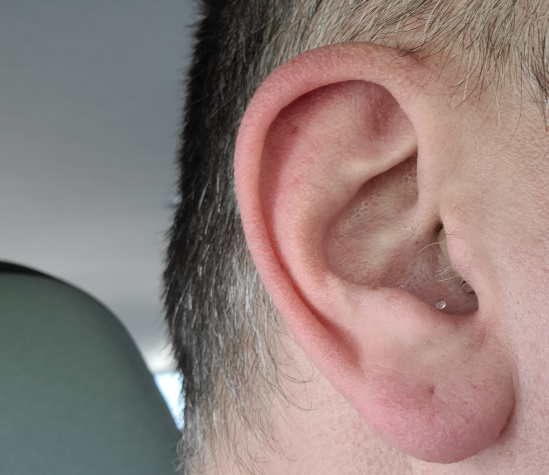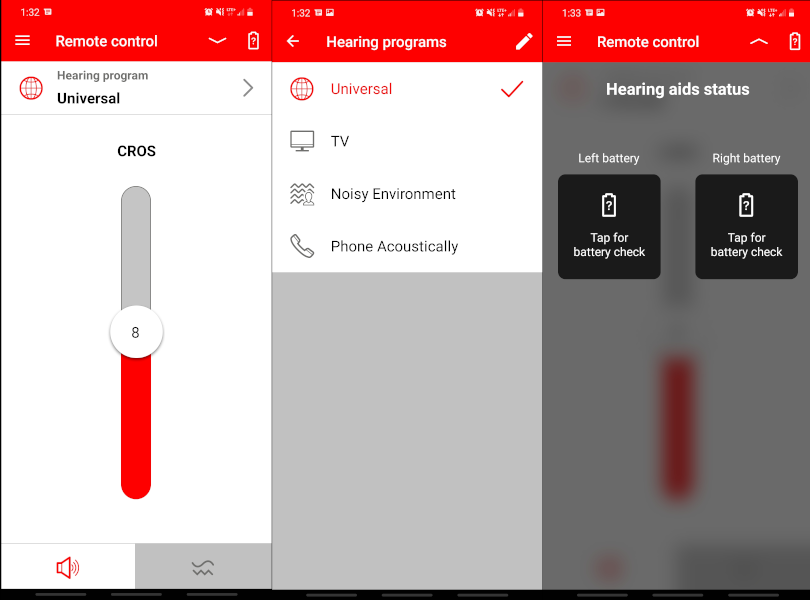Model tested: Signia Silk 5X (right side), Silk CROS (left side).

Table of Contents
Design
The Signia Silk X is a completely-in-canal (CIC) hearing aid, which right off the bat differentiates it from every other CROS hearing aid solution I’ve tried so far (which were all Receiver In Canal or RIC models). You can read about different types of hearing aids here. As someone who lost part of their hearing at a relatively young age (30), I feel a lot less self-conscious wearing these hearing aids in public and at work due to their very conspicuous design. Whether we want to admit it to ourselves or each other (or are even aware of it), many people can be based against the deaf and partially deaf.
Anyway, not to repeat myself too much, these aids are extremely tiny, to the point where I was anxious that I might either get them stuck in my ear and unable to get them out, or just drop them and lose them entirely. Happily, neither of those things has happened so far. Regarding falling out of my ear, the little silicon (or similar material) sleeve keeps it fairly well situated in the ear, and they feel pretty secure, while also somehow not blocking all the sound coming into the bad ear.
This design is extremely beneficial, because one of the main problems of mono-hearing is that you lose some or all ability to determine the direction of sounds (echo location, if you will). By still allowing some sound in, the Silk X units do not fully block sound entering your bad ear, and thus don’t impair all ability to determine location. Or more precisely, they at least do not interfere with it as much as the RIC hearing aids I’ve tried. Of course if you didn’t have good sound locality before, it doesn’t magically add any additional capability, but it definitely hinders it less than other aids I’ve tried.
The hearing aids have a simple plastic wire attached with a ball on the end. To remove them from your ear, you just grab the ball and pull, and the aid slips out of your ear with ease. As you can see in the very ugly picture of my unkempt ear area, all that’s visible from the outside is the little clear ball. Replacing the batteries is the same as other units as well, there is a little flap on the back which your thumbnail can easily flip open to access the battery.

Cost and Models
As with my previous article, if you live in the United States, you know the state of hearing aid coverage from US insurance companies. In a nutshell, it’s bad. I did find one company which was willing to fight with my insurance company to get one of the 3 aids I’ve tried covered. For the Silk X units, I did not employ that company, and like the Oticons S2s, ended up paying out of pocket.
My final cost for the Silk 5X and CROS hearing aid unit combo (and not much else) came to around $3400 in the suburban Boston hearing aid office I used; depending on where you live these units could be either less or more expensive. There are also several different models of the Silk X, hence why they are often referred to as the Silk NX. These different models offer different levels of sound adjustment, noise cancellation, and so forth, and a corresponding price increase from the lease expensive 1X model, up to the fanciest 7X model. I ended up at the 5X which offered most of the feature of the pricier 7X unit, but at a somewhat cheaper price.
Now that all that is out of the way, a bit more about my experience with the hearing aids themselves. I wore the units for two to three weeks in a mixture of indoor, outdoor, work and non-work environments. From that I think I have a pretty decent handle on the units, especially compared to previous hearing aids I’ve tired, and I’d like to share my opinions about these units for your reading pleasure.
Pros
There is a lot of good to talk about with the Signia Silk X, so let’s get started.
Design lets more sound in on your bad side
As mentioned above, letting in some sound into your bad ear due to the miniature design means I have usually at least some idea of where sounds are originating from. With the other CROS models I’ve tried, this has been a much bigger issue as they effectively block the majority of noise in my bad ear.
Virtually no wind noise!
One thing I really didn’t think about when wearing the Silks until much later was the almost complete lack of wind noise. With behind-the-ear/receiver-in-canal models, the microphone is much more exposed to wind noise, and when you’re walking on a windy day you really notice what sounds like someone blowing into a microphone. The better models I’ve used will catch the burst of noise and mute or substantially reduce its volume, but it’s still very noticeable.
By nature of how the entire Silk unit fits inside your ear, it just does not have this problem at all. I realize I’m being a bit repetitive but for those who wear hearing aids, you know all about this. Wind noise can be a major deterrent to even wanting to put your aids in after experiencing a windy day the day before, just from association with the irritation the sound causes. Removing this issue means I’m much more likely to not only keep the Silk units turned on when walking outside during the day, but more likely to put them in to begin with.
No interference with glasses, face masks, or headphones
Another benefit (especially in the post-COVID world) is that the total-in-ear design of the Silk X means that glasses, facemasks, etc, can sit on or go behind your ear with no effect on your hearing aids. I wear glasses primarily when driving, so having to take out my aids, put on my glasses, and then reverse the process was quite a chore when trying to get to a meeting after fighting Boston traffic. Or if I left both the aids and glasses on, my glasses would feel uncomfortable trying to share the space behind my ears, or resting on the wire which connected the speaker to the receiver. Again just the design of the Silk X eliminates this complication.
I especially enjoyed that I could use over-the-ear headphones while at work without needing to take the units out. I think if you were in the habit of wearing headphones for hours at a time, it would probably make more sense to just take the Silk X out, but it’s not totally a requirement, which a nice Quality of Life improvement.
One unexpected benefit of wearing the Silk Xs with the headphones is that wearing them under my work headphones meant I wasn’t missing any sounds which would normally come into one ear. This was generally only noticeable when I was listening to music, but was a nice bonus. And, of course when I was going to get up from my desk to take a break, or a coworker came over to chat, I could just slip down the headphones and the Silk Xs were already in my ears. They were already in and enabled, ready to assist my hearing, regardless of where my coworker ended up standing.
Very good battery life despite using a smaller battery
I was honestly worried when I saw how small the size 10 batteries were compared to the more common 312 type. This was primarily due to having a bit of a stockpile of the other type, but having to frequently change out batteries was an immediate worry also.
However I was easily able to get about 3 days of business-hours wearing of the units, so turned out to not be a concern after all. Honestly after my experience with the Livio rechargeable units and how relatively quickly they charged in the case, I’d probably prefer to have rechargeable units after all, as non-removable batteries can be designed to be slightly larger capacity in the same amount of space. But, everyone has their preference on rechargeable vs replaceable batteries after all, and these units only run on batteries, so there we are.
If you do need to buy some size 10 battery replacements, you can get some good replacement units right from Amazon for fairly cheap (affiliate link).
Cons
No Bluetooth or ASHA compatibility; fewer accessories than traditional aids
One of the things I liked about the other hearing aids I’ve tried is having Bluetooth compatibility, as it’s a very flexible standard and can allow easy access to phone calls while wearing your hearing aids. The next step down in terms of compatibility and flexibility is the ASHA standard, which many Samsung, Google, and iOS devices support. This allows you to at least take phone calls through your hearing aid, even if it doesn’t provide the wide compatibility with music apps and the like.
As far as I’m aware the Silk X does not work with either standard, and I could not find a way to make them available for pairing via my Pixel 5. The Signia website does claim the Silk X is available for remote pairing for adjustment by your hearing provider, which will probably enable you to save some mileage on your car when the Silk Xs require an adjustment. I was not able to try this feature out as of yet.
Another downside with these units in particular is that there also seem to be fewer accessories compatible with the Silk X. Notably, many hearing aids have a remote transmitter (purchased separately) which allows you to place a wireless microphone close to a speaker/person speaking in, say, a crowded lecture hall or conference room. This transmits the audio from near that person to your hearing aid, rather than picking up all the noises between you and the speaker. Signia’s version of this, the StreamLine Microphone, does not work with the Silk X, seemingly due to the unit’s lack of Bluetooth.
Companion App is fairly basic
Compared the Oticon or even Livio app, I find the accompanying Android app to the Silk X to be pretty barebones. You can adjust volume, there are a few sound profiles you can switch between, and there is a nice built-in battery check test you can run, but otherwise the app is fairly basic. This is not necessarily a bad thing, depending on how much complexity you’re looking for in a hearing add Android app. I did not test any iOS version of the application unfortunately.

Occasional artificial ‘noises’
As any hearing aid wearer knows, artificial feedback/’computer glitch’ sounds are an unfortunate part of wearing hearing aids, full stop. It’s just a fact or life and you get used to it over time. I do feel like on the Silk X these sounds are somewhat more frequently heard compared the BTE models I’ve tried before, notably compared to the Oticon S2. But, the lack of wind noise makes this a pretty easy tradeoff for me, as you get used to the short glitch sounds and dismiss them
Verdict
Overall, I really like the Signia Silk X with CROS. As a younger sufferer of single-sided deafness, I value a discreet design and comfort very highly. As someone who also wears glasses (and recently facemasks), the nature of their design makes them unbeatable for not interfering with things that rest on or behind the ear. The occasional glitchy feedback noises and lack of Bluetooth/ASHA are something I can adjust to, expecially as I can still use them at the same time as on-ear headphones. And finally, the price is acceptable and honestly fairly in line with other hearing aids I’ve tried.
At the end of the day, one of the main problems of single-sided deafness is whether a CROS hearing aid really affords you much benefit. They can be expensive, and disposable batteries can be wasteful. You can in many situations adjust your position to hear sounds when necessary, you can cup your ear to a direction, you can lip read, and unfortunately no technology today in a hearing aids is going to help you enjoy stereo music.
I honestly go long periods without wearing hearing aids, but the Silk Xs are the first ones I’ve actually wanted to go back to in most hearing situation. That’s probably as much of a recommendation as you can get for devices like these.
Disclaimers
I purchases these aids with my own money, and I have no relationship with any company or product mentioned in the article unless otherwise noted. No company has received advanced copy nor any editorial approval of this article. If you buy an item from an affiliate link provided, I may get a commission based on the sale. This helps me run the site, and I greatly appreciate the support.

